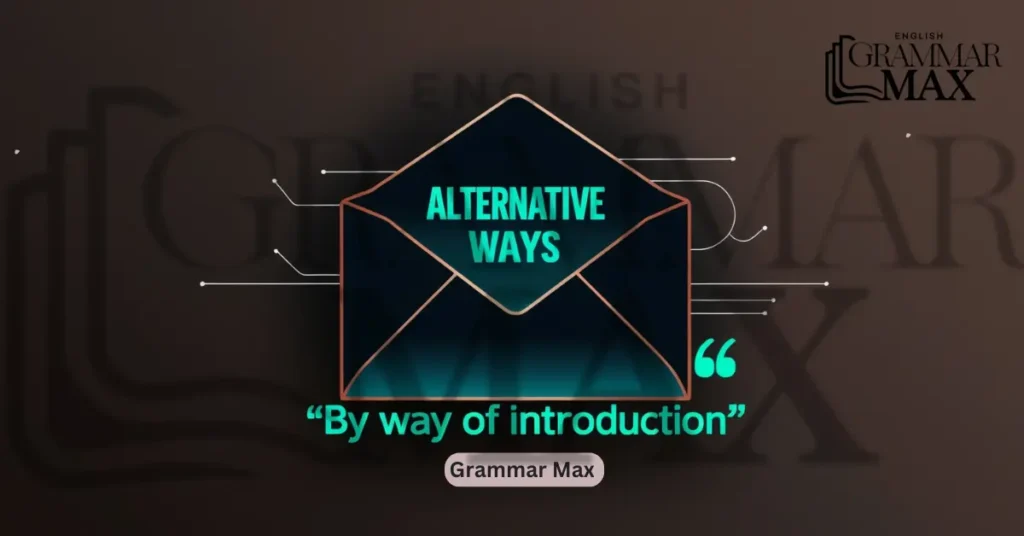By way of introduction, emails play a crucial role in professional communication, and how you introduce yourself can set the tone for the entire conversation. While “By way of introduction” is widely used, it’s helpful to explore alternatives that suit various situations. Crafting the right email introduction can enhance your ability to create a positive first impression and build professional rapport.
Whether you’re making a self-introduction or introducing others, using diverse phrases can tailor your introduction style to the occasion. We’ll explore 20 alternatives that help you leave a lasting and professional impact in your emails.
Alternative Ways to Say “By Way of Introduction”

You can use these ways instead to say “By Way of Introduction”:
- Permit Me to Introduce
- Allow Me to Introduce
- May I Introduce
- To Kick Things Off
- As an Introductory Remark
- To Start Things Off
- Let Me Introduce
- By Way of Preface
- To Begin With
- Set the Stage
- To Commence
- First Things First
- Before We Proceed
- Let’s Begin With
- I’d Like to Start By Introducing
- To Get Started
- Let’s Kick Off With
- By Way of Preface
- To Set the Tone
- By Way of Opening
Permit Me to Introduce
“Permit me to introduce” offers a polite introduction with a sense of formality. This phrase works well in business emails where you want to appear respectful yet professional. It can be particularly effective when introducing yourself to senior colleagues or clients.
Example:
Subject: Introducing Our New Team Member
Dear Team,
Permit me to introduce our new Marketing Specialist, Lisa Thompson. With over five years of experience in digital marketing, she will be a valuable addition to our team.
Please join me in welcoming Lisa!
Best,
Michael Smith
Marketing Manager
Allow Me to Introduce
“Allow me to introduce” is another formal way to begin a professional email introduction. It maintains a polite tone and can be used when making introductions in a business environment. It’s also versatile and works well for self-presentation or introducing others.
Best Use:
Allow me to introduce it best used in formal email communications when you want to present yourself or someone else with respect and professionalism. This phrase sets a polite tone and is ideal for initial introductions in business contexts, ensuring a positive first impression.
May I Introduce
Using “May I introduce” carries an air of formality and is ideal for business settings. It’s perfect for email scenarios where professional rapport is critical, such as client meetings or networking emails.
Best Use:
May I introduce is best used in formal settings where you want to establish a professional tone while introducing yourself or someone else. It’s particularly effective in business emails or meetings, ensuring your introduction comes across as respectful and polished.
Email Example: “May I introduce myself? I’m Emily Foster, and I’ll be handling your account going forward.”
To Kick Things Off
This phrase is more casual but still appropriate in business communication. It signals the beginning of the discussion while sounding approachable. “To kick things off” is ideal when you’re moving into a new project or conversation.
Email Example:
Subject: Kickoff Meeting Agenda Hi Team,
To kick things off, I’d like to introduce our new project, “Innovate 2024.” We will discuss the objectives and timeline in our meeting on Thursday at 10 AM.
Looking forward to seeing you all there!
Best,
Sarah Johnson
Project Manager
As an introductory remark
“As an introductory remark” is a useful alternative when making a structured introduction. It signals that the upcoming message will serve as an entry point into a broader conversation.
Best Use:
“As an introductory remark” is best used in formal emails or presentations to smoothly transition into the main content. This phrase sets a professional tone and prepares the audience for important information.
To Start Things Off
Another slightly informal phrase, “To start things off,” is great for email introductions when you’re initiating a conversation or task. It sounds friendly yet professional.
Email Example:
Subject: Welcome to the Team! Hi Everyone,
To start things off, I’d like to introduce our new team member, Alex Brown, who will be joining us as a Software Developer. Let’s all welcome him and make him feel at home!
Best,
Emily Davis
Team Lead
Let Me Introduce
“Let me introduce” is a simple and effective phrase for making professional introductions. It works in both formal and informal settings and can be used to introduce yourself or others.
Best Use:
“Let me introduce” is best used in professional emails when presenting yourself or someone else in a formal context. This phrase establishes a respectful tone, making it ideal for initial introductions in business settings, networking events, or team meetings.
Email Example:
Subject: Introduction of Our New Client Dear Team,
Let me introduce our new client, GreenTech Innovations. They specialize in sustainable technology and are excited to collaborate with us on upcoming projects.
Best regards,
David Lee
Account Manager
By Way of Preface
“By way of preface” serves as a formal phrase used to introduce a subject or provide context before delving into the main topic. It effectively sets the stage for what follows, allowing the reader to understand the relevance or significance of the upcoming content.
Using “by way of preface” can enhance the clarity and structure of your communication, particularly in professional emails or presentations. It signals that the following remarks will provide essential background information, ensuring that your audience is well-prepared to engage with the main points.
To Begin With
“To begin with” is an effective phrase for initiating a discussion or email, signaling that you are starting your introduction or the main points of your message. This phrase is versatile and can be used in both formal and informal contexts, making it suitable for various professional settings.
Using “to begin with” sets a clear structure for your communication, allowing you to present your thoughts in an organized manner. It helps prepare the recipient for the information that follows, ensuring that your message is received with clarity and purpose.
Email Example: “To begin with, I’d like to introduce myself as the new team leader for the project.”
Set the Stage
“Set the stage” is a phrase that helps provide context before delving into the details. It’s a more creative way of saying you’re about to introduce something important.
Best Use:
“Set the stage” is ideal for emails where you want to provide context before introducing a topic or person. This phrase enhances understanding and prepares the recipient for the upcoming discussion, making it particularly effective in formal communications.
Email Example: “To set the stage, I’d like to give you a bit of background on our company before introducing the team.”
Is it Professional to Say “By Way of Introduction”?

Yes, it is considered a polite and formal way to introduce yourself or others in an email. However, while it conveys respect and professionalism, it can sometimes feel a bit outdated or overly formal in certain contexts. It’s important to assess the tone and formality of your business communication before using it, as more modern alternatives might be better suited for a particular professional setting or audience.
Frequently Asked Questions
Can I use by way of introduction?
Yes, you can use “by way of introduction” in a professional email, especially in formal settings. However, it’s a bit formal, so consider the context before using it.
What does by way of an introduction mean?
“By way of an introduction” is a formal phrase used to introduce yourself or someone else, providing a polite entry into a conversation or email.
What to say instead of “by way of introduction”?
You can say “Permit me to introduce,” “Allow me to introduce,” or “To kick things off” as alternatives to “by way of introduction,” depending on the tone and formality required.
How do you introduce yourself in a professional email?
In a professional email, introduce yourself clearly by stating your name, role, and purpose of reaching out, ensuring the tone matches the professional setting.
Conclusion
Choosing the right introduction style can greatly influence the effectiveness of your email communication. Using diverse alternatives to “By way of introduction” helps ensure your message feels tailored and professional. Whether you’re in a formal setting or a casual business interaction, the right phrase makes a lasting first impression.
Exploring these 20 alternatives allows you to adjust your tone for different situations, creating a more personalized self introduction. Whether it’s a polite introduction or a structured approach, selecting the right words enhances your professional rapport and ensures your message resonates.

William Henry is a writer for Grammar Max, a blog that focuses on synonyms and phrases. He loves exploring the quirks of the English language and enjoys helping readers improve their vocabulary. William’s articles are easy to read, fun, and full of useful tips for anyone looking to better understand and use English. Whether you’re a student, a professional, or just someone interested in language, William’s writing on Grammar Max makes learning about words and their meanings simple and enjoyable.















